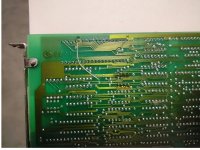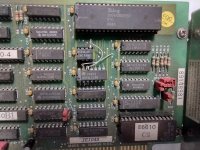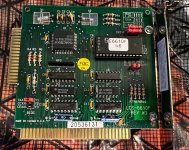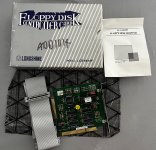Modifying A PC-XT "Clone" Controller For Single-Density Reading
Got a bunch of Xerox 820 diskettes that you'd love to be able to read?
Sold your Osborne I at a swap meet and need your correspondence files
from 1981? Too bad, your PC can't handle single-density diskettes...
Or can it?
Well, it can be done with a little patience, a few bits of wire, and a
small soldering iron. The result is a controller that remains PC-
compatible as far as any DOS software can tell, but has an extra FM
mode in addition.
Do not attempt this modification unless you really know what you're
doing and have worked with this kind of equipment before. This is no
place for a novice.
First, you need to determine the type of controller you're using. The
original IBM PC and PC/XT controllers are NOT readily adaptable, but
most inexpensive clones are.
The important thing to locate on the controller card is the data
separator chip; it's an 8-pin DIP. It looks something like this:
Page 23
+--U--+
Pin 1 | | Pin 8
Pin 2 | | Pin 7
Pin 3 | | Pin 6
Pin 4 | | Pin 5
+-----+
(Top View)
This DIP (Dual Inline Package) will have pins 4, 5 and 6 grounded and
pin 8 connected to the +5 supply trace. Numbering of this device
varies -- Western Digital (the prime source) has it as a WD 9216; a
NEC part number is UM 8326. But it's all the same as far as we're
concerned.
Identify the diskette controller chip on your board -- this is the
large 40 pin DIP labeled uPD765A (NEC), Z765A (Zilog), or 8272A
(Intel). Note that pin 26 is a no-connection on your card -- this is
the MFM/FM mode output pin.
The last thing you need to find is an unused inverter section. This
is the most difficult part of this whole modification. Most cards use
a SN7404 or 'S04 as an oscillator (look near the crystal). Usually,
not all sections are used. Or look for a section of an 'LS00 gate or
some such thing that can be wired as an inverter (Hint: tie both in-
puts together).
You need to lift pin 5 of the 8-pin data separator (above) from
ground. Depending on how your card is laid out, this can be quick and
simple (cut the ground trace) or very messy (unsolder the whole chip).
Connect a wire (wire-wrap wire is great) between this pin 5 and the
output of the inverter which you located. Connect a second wire be-
tween pin 26 of the floppy disk controller (uPD 765) and the input of
the inverter.
That's it -- put the card back into your PC and make sure it still
handles regular DOS diskettes okay.
If you've got an AT-style controller or a Western Digital 'Fox' dual-
density XT controller, you can even drive SD and DD 8" diskettes with
this modification.
Note that this simple modification will enable you to read single-
density diskettes, but not to write them. If you're really adven-
turous, an XT-style controller can be made to write diskettes if the
write-precompensation circuitry is bypassed. We do it here with a
section of a 74LS157 driven from the MFM pin of the '765. A schematic
of your controller is a must for this kind of work.




